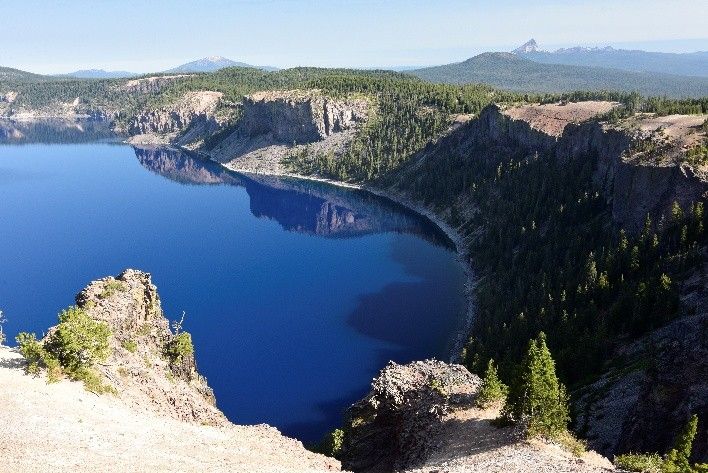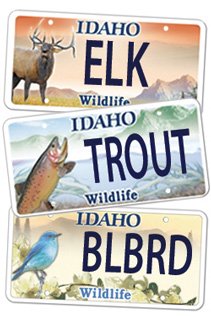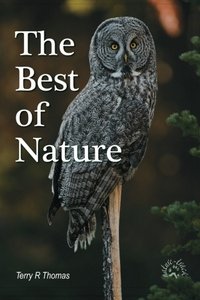Ecosystems

©Terry R. Thomas/www.nature-track.com
The steep sides of Crater Lake, Oregon, make it fairly easy to define the ecosystem here.
In the natural world, scientists are constantly searching for words and phrases to describe different phenomena. As a result, like most other disciplines, the study of the natural world is full of new and often strange words. Get involved in it deeply enough and it is like learning a new language.
Listening to a presentation last week, the word, ecosystem, came up several times and it was clear that not everyone had a full understanding of that word, and with good reason. An ecosystem, even though it may have a single definition, has dozens of different examples and levels (the human body is an ecosystem with thousands of species living on and in it), and smaller ecosystems may join to form larger ones. It is a concept often not easy to grasp.
Here is a common definition of an ecosystem: “An ecosystem is the term used to describe all of the organisms - plants, animals etc., as well as all the environmental factors - such as landscape, weather and climate, which exist in a given area to create a functioning interconnected system of life. That ecosystem is a specific geographic area, but includes all factors, both living and nonliving, which exist inside that area.”
Ecosystems are usually larger than habitats and may contain multiple habitat types. The key here is that the system is interconnected, the needs of all members are met within it, and all parts play a role in the function. Start removing players and subtle changes to the ecosystem can occur, eventually making it something different than what it started out as.
So, we can quickly name some of Earth’s larger biomes: boreal, temperate, and tropical rain forests for instance. There are deserts, grasslands, and tundra, oceans, freshwater, and the Arctic. However, without a geographic location attached, these are biomes, not ecosystems (although the distinction between the two remains a bit obscure). So, location is important (as the definition states) because an ecosystem must function as a unit.
Deciding where an ecosystem begins and ends is often a challenge. For instance, lakes are often considered ecosystems that comprise the shoreline, shallow water, and deep water. However, how about the source streams and rivers and the roles that they play in nutrient cycling, temperature control, and spawning habitat for the lake’s inhabitants? Should they be included in the ecosystem and if so, where do they end?
In Yellowstone National Park, there are many smaller ecosystems that to some degree or another play a part in larger ecosystems. Park naturalists recognize many ecosystems within the park. As a whole, “Yellowstone National Park is described as a temperate-zone ecosystem. This means there are obvious differences in temperature during the seasons. The summers are warm to hot and winters cool to cold.” There are also geyser ecosystems, important to the Yellowstone ecosystem because of the micro climates they can create. Then there are freshwater systems such as Yellowstone Lake, the largest mountain lake in the nation, as well as other lakes and rivers. Then there are forest ecosystems which cover around 80 percent of park with subalpine firs, Engelmann spruce, limber pine, and lodgepole pine trees. In the northern, lower elevation region of the park, you can find a lot of Douglas-fir trees. Then there are mountain ecosystems with differing communities as the elevation climbs, and grassland ecosystems, again with different communities depending on the location.
All of these, and likely many more, ecosystems exist within Yellowstone National Park. Each functions with its own feedback systems, yet they are all linked into a larger ecosystem. Sometimes they are easy to see separately, such as thermal features. Often though, it is difficult to find boundaries as transitions are often very broad.
Finally, understanding that ecosystems are dynamic is important. While an ecosystem tends toward an equilibrium state, disturbances such as fire, landslides, storms, and more keep an ecosystem in a constant state of recovery. If an ecosystem can remain close to equilibrium even with disturbances, it is said to be resistant. If it can absorb disturbance and change and essentially retain its identity and function, it is considered to have higher ecological resilience.
This all applies to a very special ecosystem that we call the Greater Yellowstone Ecosystem, or GYE. More on that next time.
Help Idaho Wildlife
When we traveled across the state in October 2017, we visited most of the Idaho Department of Fish and Game wildlife management areas. Most of the vehicles we saw using the wildlife management areas did not have wildlife plates. Buying wildlife plates is a great way for non-hunters and hunters alike to support wildlife-based recreation like birding.
C'mon folks, let's help Idaho's wildlife by proudly buying and displaying a wildlife license plate on each of our vehicles!
See below for information on Idaho plates. Most states have wildlife plates so if you live outside Idaho, check with your state's wildlife department or vehicle licensing division for availability of state wildlife plates where you live.
And tell them that you heard about it from Nature-track.com!

Wildlife License Plates
Great news! as of 2024, there are three NEW designs for license plates. They still are bluebird, cutthroat trout and elk, but they are beautiful.
Idaho Wildlife license plates provide essential funding that benefits the great diversity of native plants and wildlife that are not hunted, fished or trapped—over 10,000 species or 98% of Idaho’s species diversity. Game species that share the same habitats (such as elk, deer, antelope, sage-grouse, salmon, trout) also benefit from these specialty plates.
No state tax dollars are provided for wildlife diversity, conservation education and recreation programs. Neither are any revenues from the sale of hunting or fishing licenses spent on nongame species. Instead, these species depend on direct donations, federal grants, fundraising initiatives—and the Idaho Wildlife license plates.
Both my vehicles have Bluebird Plates. I prefer the bluebird because the nongame program gets 70 percent of the money from bluebird plates, but only 60 percent of the money from elk and trout plates - 10 percent of the money from elk plates supports wildlife disease monitoring and testing programs (to benefit the livestock industry) and 10 percent from cutthroat plates supports non-motorized boat access.
Incidentally, in 2014, the Idaho Legislature denied the Department of Fish and Game the ability to add new plates or even to change the name of the elk and cutthroat plates (very specific) to wildlife and fish plates, a move that would have allowed for changing images occasionally and generating more revenue. It would seem that they believe that we Idahoans don't want a well funded wildlife program.
I think it is time we let the Legislature know that Idahoan support wildlife funding and that we would like to see these generic plates come to fruition.

"WOW. What a phenomenal piece you wrote. You are amazing." Jennifer Jackson
That is embarrassing, but actually a fairly typical response to my nature essays. Since The Best of Nature is created from the very best of 16 years of these nature essays published weekly in the Idaho Falls Post Register (online readership 70,000), it is a fine read. It covers a wide variety of topics including humorous glimpses of nature, philosophy, natural history, and conservation. Readers praise the style, breadth of subject matter and my ability to communicate complex and emotional topics in a relaxed and understandable manner.
Everyone can find something to love in this book. From teenagers to octogenarians, from the coffee shop to the school room, these nature essays are widely read and enjoyed.
Some of the essays here are my personal favorites, others seemed to strike a chord with readers. Most have an important message or lesson that will resonate with you. They are written with a goal to simultaneously entertain and educate about the wonderful workings of nature. Some will make you laugh out loud and others will bring a tear to the eye and warm your heart.
Readers Write:
"You hit a home run with your article on, Big Questions in Nature. It should be required reading for everyone who has lost touch with nature...great job!" Joe Chapman
"We enjoyed your column, Bloom Where Planted. Some of the best writing yet. The Post Register is fortunate to have your weekly columns." Lou Griffin.
To read more and to order a copy, click here or get the Kindle version
Copies are also available at:
Post Register
Island Park Builders Supply (upstairs)
Barnes and Noble in Idaho Falls
Harriman State Park, Island Park
Museum of Idaho
Valley Books, Jackson Wyoming
Avocet Corner Bookstore, Bear River National Wildlife Refuge, Brigham City, Utah
Craters of the Moon National Monument Bookstore, Arco, Idaho